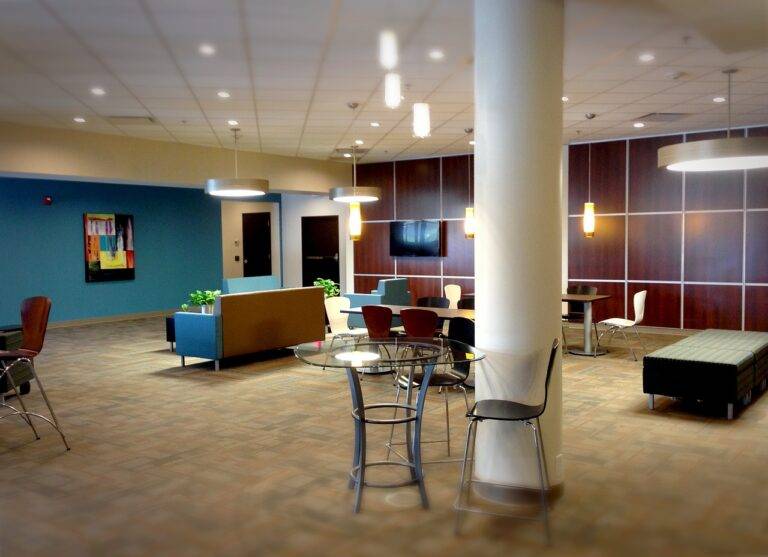Commercial Ceiling Fan: The Ultimate Air Circulation Solution for Large Spaces
When it comes to efficiently cooling and ventilating large spaces like warehouses, factories, gyms, retail stores, and restaurants, Commercial Ceiling Fan emerge as one of the most practical and cost-effective solutions. These industrial-strength fans are designed for durability, performance, and energy efficiency, making them ideal for commercial and industrial settings where air circulation is a top priority.
In this comprehensive guide, we will explore what commercial ceiling fans are, how they differ from residential fans, their benefits, types, installation tips, maintenance practices, and more. Whether you’re managing a facility or designing a new workspace, understanding commercial ceiling fans will help you make informed decisions about your cooling and ventilation needs.
What Is a Commercial Ceiling Fan?
A commercial ceiling fan is a heavy-duty ceiling-mounted fan engineered for large spaces. Unlike residential fans, which are generally smaller and designed for aesthetic appeal, commercial ceiling fans focus on function over form. They are built with high-performance motors and wider blade spans to move large volumes of air effectively.
These fans are typically found in:
Warehouses and distribution centers
Manufacturing plants
Gyms and fitness centers
Commercial kitchens and restaurants
Retail showrooms
Educational institutions
Auditoriums and event halls
Key Features of Commercial Ceiling Fans
1. High Airflow Capacity
Commercial ceiling fans are designed to circulate air in large, open areas. They have a high CFM (Cubic Feet per Minute) rating, which means they can move significantly more air compared to standard ceiling fans.
2. Larger Blade Span
The blade span of commercial ceiling fans typically ranges from 48 inches to over 100 inches. The wider the blade span, the greater the area of air movement.
3. Durable Construction
Built for longevity, commercial ceiling fans are made from industrial-grade materials such as aluminum, steel, or composite. Their finishes often resist corrosion, dust, and humidity.
4. Energy Efficiency
Despite their size, many commercial fans are surprisingly energy-efficient. Some models are compatible with energy management systems, timers, or occupancy sensors to reduce energy consumption.
5. Quiet Operation
Designed with precision engineering, modern commercial ceiling fans are much quieter than older models, making them suitable even for offices and educational settings.
Benefits of Installing a Commercial Ceiling Fan
1. Enhanced Air Circulation
One of the biggest advantages is the ability to circulate air evenly across large spaces. This not only cools down the environment but also helps in eliminating hot and cold spots.
2. Improved Comfort
Even in non-air-conditioned spaces, the airflow from a commercial ceiling fan can make a significant difference in perceived temperature, keeping employees and customers comfortable.
3. Cost-Effective Cooling
Commercial fans can reduce reliance on air conditioning by lowering the effective temperature through air movement. This results in lower energy bills over time.
4. Improved Indoor Air Quality
Proper air circulation helps in removing odors, fumes, and stale air, which is especially important in industrial and kitchen settings.
5. Reduced HVAC Load
When used in conjunction with air conditioning systems, ceiling fans can reduce the strain on HVAC units, potentially extending their lifespan and reducing maintenance costs.
Types of Commercial Ceiling Fans
1. Standard Commercial Ceiling Fans
These are basic models designed for general air movement in commercial settings. They offer solid performance and are suitable for smaller commercial areas.
2. High-Volume Low-Speed (HVLS) Fans
HVLS fans are massive in size and move large volumes of air at low rotational speeds. Ideal for large warehouses and gymnasiums, they are designed to improve air circulation efficiently with minimal energy use.
3. Wet-Rated or Damp-Rated Fans
These fans are designed for use in areas with high humidity or exposure to moisture, such as commercial kitchens, patios, or greenhouses.
4. Reversible Motor Fans
Some commercial fans come with reversible motors to allow both summer and winter use. In summer, they push cool air down; in winter, they redistribute warm air trapped near the ceiling.
Where to Use Commercial Ceiling Fans
Warehouses and Distribution Centers
With high ceilings and constant activity, warehouses benefit greatly from fans that maintain consistent air flow and help regulate temperature.
Retail Stores
Strategically placed fans help maintain a pleasant shopping environment without depending entirely on air conditioning.
Gyms and Sports Facilities
These spaces generate a lot of body heat and sweat. Ceiling fans keep air moving, reducing odors and maintaining comfort.
Restaurants and Commercial Kitchens
Fans in these environments assist in ventilation, odor control, and cooling, especially in hot kitchen areas.
Schools and Educational Institutions
Proper air flow enhances concentration and comfort in classrooms and study halls.
Factors to Consider Before Installation
1. Ceiling Height
Most commercial fans are ideal for ceilings over 10 feet in height. For higher ceilings, longer downrods may be needed to position the fan effectively.
2. Room Size
The size of the fan should match the dimensions of the room. Larger rooms typically need fans with a blade span of 60 inches or more.
3. Airflow Requirements
Consider the CFM rating to ensure the fan can handle your space’s airflow needs.
4. Environmental Conditions
If your environment involves humidity, dust, or exposure to chemicals, choose a fan that’s rated for such conditions.
5. Mounting and Support
Check the ceiling’s structural capacity. Commercial fans are heavier and require sturdy mounting brackets or reinforcements.
Installation Tips
Always have a qualified electrician handle the installation.
Follow the manufacturer’s installation instructions carefully.
Ensure that the fan blades have sufficient clearance from walls and ceilings.
Balance the blades after installation to ensure smooth operation.
Test the fan at all speeds and directions before regular use.
Maintenance and Safety
Regular Cleaning
Dust and debris can affect the efficiency of fan blades. Regular wiping with a dry or slightly damp cloth can prevent buildup.
Motor Inspection
Check for unusual noises, overheating, or vibration, which could indicate motor issues.
Blade Balancing
Imbalanced blades can reduce airflow efficiency and increase wear on the motor. Use blade balancing kits if necessary.
Tighten Screws and Bolts
Periodic tightening of mounting hardware ensures the fan remains securely installed.
Switch Off for Servicing
Always cut power before inspecting or cleaning the fan.
Environmental Impact
Commercial ceiling fans offer a green alternative to heavy HVAC usage. By enhancing air circulation, they reduce the need for high-energy cooling systems. Moreover, many models are manufactured with recyclable materials and energy-efficient motors, aligning with sustainability goals in commercial operations.
Common Myths About Commercial Ceiling Fans
Myth 1: Bigger Fans Use More Energy
Contrary to belief, larger HVLS fans often consume less energy than smaller high-speed fans due to their efficient design.
Myth 2: Fans Cool the Air
Fans do not cool the air temperature but create a wind-chill effect that makes the environment feel cooler.
Myth 3: Ceiling Fans Are Outdated
Modern commercial ceiling fans are packed with features like remote control, variable speed settings, and smart automation, making them highly relevant today.
Conclusion
A commercial ceiling fan is an indispensable addition to any large space where temperature control, ventilation, and energy efficiency are priorities. Whether you’re trying to reduce your reliance on air conditioning or looking to create a more comfortable environment for staff and customers, these fans provide an economical and eco-friendly solution.
From warehouses to retail stores, gyms to classrooms, commercial ceiling fans improve air circulation, boost comfort, and contribute to better productivity. With the right selection, installation, and maintenance, they can offer years of reliable service and operational savings.
Frequently Asked Questions (FAQ)
1. Can a commercial ceiling fan be used in residential settings?
While it is technically possible, commercial ceiling fans are usually too large and powerful for standard homes. They are better suited to large, open-plan residential spaces like lofts or barns.
2. How high should the ceiling be to install a commercial ceiling fan?
Most commercial fans require ceilings that are at least 10 feet high to ensure safety and optimal air circulation.
3. Are commercial ceiling fans energy-efficient?
Yes. Many commercial ceiling fans, especially HVLS models, are designed to deliver high performance while consuming less electricity than traditional cooling systems.
4. Can commercial ceiling fans be installed outdoors?
Yes, but make sure the fan is damp-rated or wet-rated, depending on the level of exposure to moisture.
5. Do commercial fans require special maintenance?
Routine maintenance includes cleaning blades, checking for vibration, and ensuring motor components are working properly. These fans are generally low-maintenance if installed and used correctly.
6. How noisy are commercial ceiling fans?
Modern commercial ceiling fans are engineered for quiet operation. However, noise levels may vary depending on size, speed, and installation quality.
7. Do ceiling fans work in winter?
Yes. In winter, reversing the direction of the blades helps circulate warm air trapped near the ceiling down to occupied levels, improving comfort and reducing heating costs.







